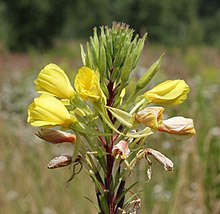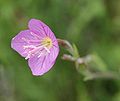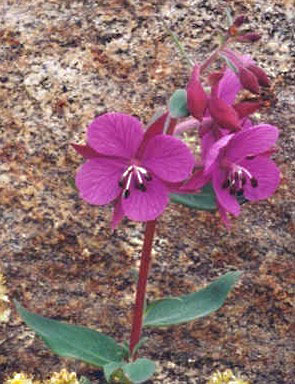
The Onagraceae are a family of flowering plants known as the willowherb family or evening primrose family. They include about 650 species of herbs, shrubs, and trees in 17 genera. The family is widespread, occurring on every continent from boreal to tropical regions.

Oenothera biennis, the common evening-primrose, is a species of flowering plant in the family Onagraceae, native to eastern and central North America, from Newfoundland west to Alberta, southeast to Florida, and southwest to Texas, and widely naturalized elsewhere in temperate and subtropical regions. Evening primrose oil is produced from the plant.

Manduca quinquemaculata, the five-spotted hawkmoth, is a brown and gray hawk moth of the family Sphingidae. The caterpillar, often referred to as the tomato hornworm, can be a major pest in gardens; they get their name from a dark projection on their posterior end and their use of tomatoes as host plants. Tomato hornworms are closely related to the tobacco hornworm Manduca sexta. This confusion arises because caterpillars of both species have similar morphologies and feed on the foliage of various plants from the family Solanaceae, so either species can be found on tobacco or tomato leaves. Because of this, the plant on which the caterpillar is found does not indicate its species.

Gaura was a genus of flowering plants in the family Onagraceae, native to North America. The name was derived from Greek γαῦρος (gaûros) meaning "superb" and named in reference to the stature and floral display of some species in this genus. The genus included many species known commonly as beeblossoms. Genetic research showed that the genus was paraphyletic unless the monotypic genus Stenosiphon is included within Gaura, increasing the number of species in the genus to 22. Gaura is now a synonym of Oenothera, with the bulk of the Gaura taxa in genus Oenotherasect. Gaura(L.) W.L.Wagner &Hoch.

Oenothera fruticosa, the narrowleaf evening primrose or narrow-leaved sundrops, is a species of flowering plant in the evening primrose family.

Oenothera caespitosa, known commonly as tufted evening primrose, desert evening primrose, rock-rose evening primrose, or fragrant evening primrose, is a perennial plant of the genus Oenothera native to much of western and central North America, in habitats such as talus slopes and sandy plains. It is normally night-blooming.
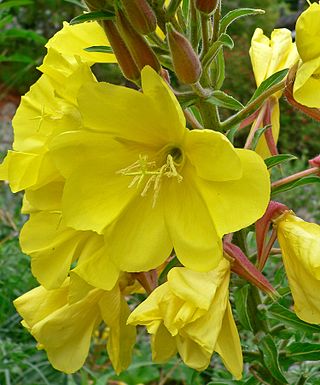
Oenothera elata is a species of Oenothera known by the common name Hooker's evening primrose or tall evening primrose. Subspecies include hookeri, hirsutissima, longisima, jamesii, villosa and elata. It is native to much of western and central North America. The plants are quite tall, especially the hookeri subspecies, native to California, which can reach about 1.8 meters height. The plants are found along roadsides, in moist meadows, or in woodland, from sea level up to 9,000 ft (2,700 m) in elevation.
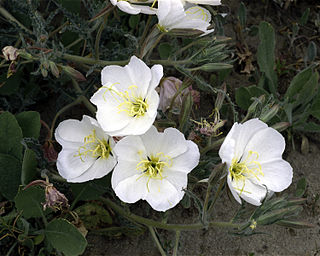
Oenothera deltoides subsp. howellii, the Antioch Dunes evening primrose, is an endangered subspecies of plant in the family Onagraceae, genus Oenothera, and species Oenothera deltoides.

Oenothera macrocarpa, the bigfruit evening primrose, Ozark sundrops, Missouri evening primrose, or Missouri primrose, is a species of flowering plant in the evening primrose family Onagraceae, native to northeast Mexico and the south-central United States, where it is found in calcareous prairies and limestone outcrops.
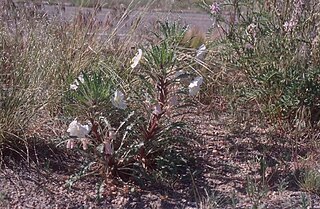
Oenothera harringtonii is a species of flowering plant in the evening primrose family known by the common names Arkansas Valley evening primrose and Colorado Springs evening primrose. It is endemic to the state of Colorado in the United States.
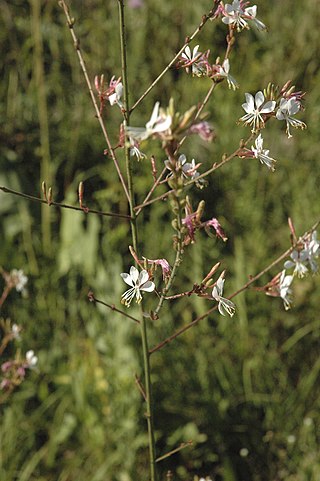
Oenothera gaura, formerly known as Gaura biennis, the biennial gaura or biennial beeblossom, is a North American flowering plant that can reach 6 ft (1.8 m) in height at maturity. Its upper half is made up of flowering stems, which are covered with soft, white hairs. It has light pink colored flowers, which turn a vibrant red/pink color in the late summer to early fall seasons. These colors make this plant attractive to butterflies and bees, and are in full bloom just before many fall plant species begin to bloom.
Plant bioacoustics refers to the creation of sound waves by plants. Measured sound emissions by plants as well as differential germination rates, growth rates and behavioral modifications in response to sound are well documented. Plants detect neighbors by means other than well-established communicative signals including volatile chemicals, light detection, direct contact and root signaling. Because sound waves travel efficiently through soil and can be produced with minimal energy expenditure, plants may use sound as a means for interpreting their environment and surroundings. Preliminary evidence supports that plants create sound in root tips when cell walls break. Because plant roots respond only to sound waves at frequencies which match waves emitted by the plants themselves, it is likely that plants can receive and transduce sound vibrations into signals to elicit behavioral modifications as a form of below ground communication.
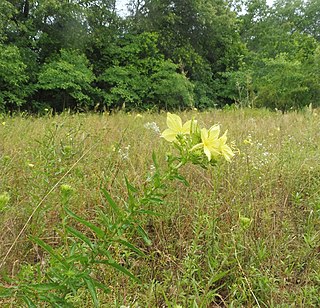
Oenothera heterophylla, commonly called variable evening-primrose, is a species of flowering plant in the evening-primrose family (Onagraceae). It is native to the South Central region of the United States, with a disjunct eastern population in Alabama. It has been recorded as an introduced waif in Missouri.

Oenothera parviflora, the northern evening primrose, is a species of flowering plant in the family Onagraceae. It is native to northeastern North America, and invasive in Europe, Asia, South Africa and New Zealand.

Robert A. Raguso is an American biologist and professor at Cornell University in the Department of Neurobiology and Behavior. He has expanded the field of chemical ecology by introducing and pioneering floral scent as a key component of plant-pollinator communication, with special focus on hawkmoths and Clarkia plants.
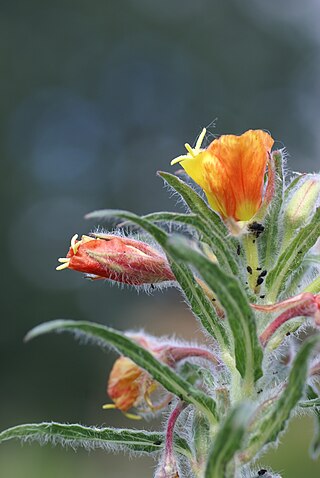
Oenothera versicolor, the red evening-primrose, is a species of flowering plant in the family Onagraceae, native to South America, from Peru and Ecuador down to Bolivia and Northern Argentina This species is not as common in cultivation as other members of the genus but popular cultivars including 'Sunset Boulevard' are grown in gardens around the temperate world as the plant is hardy down to at least −10 °C (14 °F).

Oenothera tetragona, the glaucous evening primrose, is a species of flowering plant in the family Onagraceae, native to eastern North America, and introduced to Germany, the Czech Republic, and Myanmar. The Royal Horticultural Society considers it a good plant to attract pollinators. There is a cultivar, 'Glaber', also known as 'Clarence Elliott'.

Oenothera stricta, the fragrant evening primrose, is a species of flowering plant in the family Onagraceae. It is native to the Desventurados Islands, Chile, and southern Argentina, and it has been introduced to many locations around the world. The unimproved species is available from commercial suppliers, as is a cultivar, 'Sulphurea'. The Royal Horticultural Society considers both to be good plants to attract pollinators.
